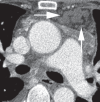Diffuse pulmonary lymphangiomatosis
- PMID: 23457676
- PMCID: PMC3628648
- DOI: 10.1155/2013/971350
Diffuse pulmonary lymphangiomatosis
Abstract
Diffuse pulmonary lymphangiomatosis (DPL) is a rare disease characterized by infiltration of the lung, pleura and mediastinum with thin-walled lymphangiomas. DPL can result in mass effect from infiltrative disease, restrictive and obstructive pulmonary physiology, chylous effusions and respiratory failure. The present article discusses clinical, radiographic and pathological features, and treatment options for DPL.
La lymphangiomatose pulmonaire diffuse (LPD) est une maladie rare caractérisée par l’infiltration de lymphangiomes à paroi mince dans les poumons, la plèvre et le médiastin. La LPD peut entraîner un effet de masse causé par la maladie infiltrante, la physiologie pulmonaire restrictive et obstructive, les effusions chyleuses et l’insuffisance respiratoire. Le présent article aborde les caractéristiques cliniques, radiographiques et pathologiques, de même que les possibilités thérapeutiques, de la LPD.
Figures




References
-
- Tazelaar HD, Kerr D, Yousem SA, Saldana MJ, Langston C, Colby TV. Diffuse pulmonary lymphangiomatosis. Hum Pathol. 1993;24:1313–22. - PubMed
-
- Faul JL, Berry GJ, Colby TV, et al. Thoracic lymphangiomas, lymphangiectasis, lymphangiomatosis, and lymphatic dysplasia syndrome. Am J Respir Crit Care Med. 2000;161:1037–46. - PubMed
-
- Swensen SJ, Hartman TE, Mayo JR, et al. Diffuse pulmonary lymphangiomatosis: CT findings. J Comput Assist Tomog. 1995;19:348–352. - PubMed
-
- Alvarez OA, Kjellin I, Zuppan CW. Thoracic lymphangiomatosis in a child. J Pediatr Hematol Oncol. 2004;26:136–41. - PubMed
-
- Sanders JS, Rosenow EC, III, Piehler JM, Gloviczki P, Brown LR. Chyloptysis (chylous sputum) due to thoracic lymphangiectasis with successful surgical correction. Arch Intern Med. 1988;148:1465–6. - PubMed
Publication types
MeSH terms
Supplementary concepts
LinkOut - more resources
Full Text Sources
Other Literature Sources
Medical

